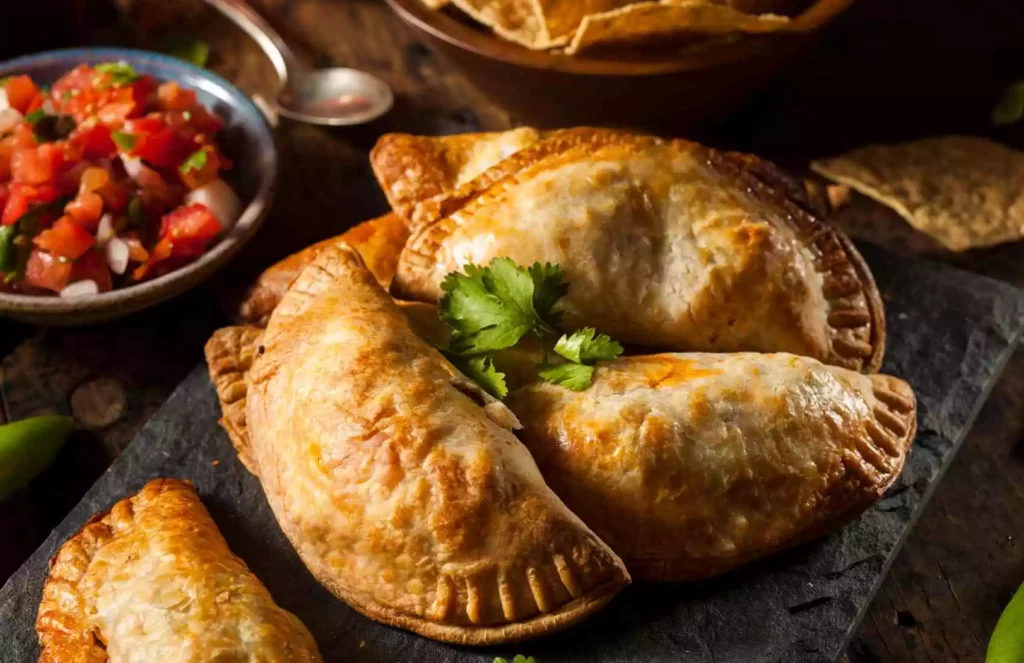Do you want to know what’s the difference between pastelitos and empanadas? Despite looking different, these two delightful pastries have been linked closely in our countries. The actual confusion has been because of the use of the words empanada and pastelito interchangeably.
Yet, today’s article will uncover their differences, apart from their shape.
So, be curious to learn them. Here we come…!
What are Pastelitos?

Pastelitos are delicious, Cuba-originated puff pastries found in various shapes and sizes, often filled with sweet or savory fillings. They’re popular in many Latin American countries. Therefore, you can find them with different names and variations, such as pastelitos in some regions, pastelillos in others, and more.
The actual name “pastelillo” comes from the Spanish word “pastel,” which means “pie.” The diminutive form of “pastel” is “pastelito,” which means “small pie.”
You can find two varieties of Pastelitos:
Sweet Pastelitos
Sweet pastelitos have sweet fillings and are a delightful treat. Some common sweet fillings include:
- Guava paste
- Sweetened cream cheese
- Fruit preserves, such as pineapple, strawberry, or mango
- Sweetened shredded coconut
Savory Pastelitos
Savory pastelitos have savory and seasoned fillings, like:
- Seasoned ground beef, chicken, or pork
- Different types of cheese, like mozzarella, cheddar, or a mix of cheeses
- Seafood mixtures like shrimp or fish in coastal regions
What are Empanadas?

Empanadas are a type of wheat dough, half-moon-shaped pastries filled with savory (mostly) or sweet ingredients. Empanadas are common in many countries in Southern Europe, Latin America, and Iberian-influenced cultures worldwide.
The name empanada comes from the Spanish word “empanar,” which means “to bread, i.e., to coat with bread.”
Empanadas are made by folding dough over a filling consisting of meat, cheese, tomato, corn, or other ingredients. They’re cooked either by baking or frying. Empanadas are pretty much like middle eastern and Indian fried pastry “samosa.”
Exploring the 9 Key Differences Between Empanadas and Pastelitos
By now, when you know that empanadas and pastelitos are two different types of pastries; we make the difference more clearly, by exploring them in detail.
1. Origin
Pastelitos are sweet puff pastries that originated in Cuba, though the word used to refer to them comes from Spanish.
The Spanish word “pastelito” simply means “small pastry.” But in the United States, the term is almost exclusively used to refer to Cuban pastries filled with guava and cheese, cream cheese, or other sweet or savory fillings, and mistakenly used to refer empanadas.
So, while the word “pastelito” is Spanish, the pastries that we know as pastelitos are Cuban–these pastries have no roots in Spain or Portugal.
In Latin America, pastelitos vary for their unique fillings and preparations, depending on the country.
For example:
- In countries like Cuba and Puerto Rico, pastelitos are often filled with sweet fillings like guava and cream cheese.
- In the Dominican Republic, pastelitos are commonly filled with savory ingredients like seasoned ground meat.
Empanadas
Empanadas have their origins in the Iberian Peninsula, specifically in Spain and Portugal.
Spanish and Portuguese explorers colonized different regions and brought their pastries, empanadas with them in the 16th century. And over time, these pastries evolved and adapted to local ingredients and flavors.
In Latin America, empanadas gained popularity, with each country developing unique fillings and preparations.
2. Dough
The dough used for pastelitos, and empanadas have some differences. Pastelitos often use flaky and buttery dough. It’s similar to puff pastry or laminated dough, which results in a light and delicate pastry. This puffiness and flakiness is achieved by layering butter, lard, or fat between thin sheets of dough.
On the other hand, empanada dough is a simple shortcrust pastry made with flour, water, and sometimes fat. This dough is sturdier, like flatbread, and more robust. It provides a slightly denser texture to encase the savory fillings commonly found in empanadas.
3. Filling
Pastelitos and empanadas differ significantly in the types of fillings used.
Pastelitos are more commonly associated with sweet fillings, such as guava, cream cheese, coconut, and fruit preserves. These sweet fillings offer a delicious contrast to the flaky pastry crust.
On the other hand, empanadas are known for their savory fillings, including seasoned ground meat (beef, chicken, or pork), cheese, vegetables, and seafood mixtures. The savory fillings in empanadas are often seasoned with herbs and spices, creating a rich and flavorful taste.
4. Size and Shape
Pastelitos and empanadas differ in size and shape, reflecting their regional variations and cultural influences.
Pastelitos are generally smaller and more delicate, and flaky. They’re often shaped into small squares, rectangles, or circles. These petite pastries are perfect for serving as bite-sized treats or dessert options.
On the other hand, empanadas tend to be larger and more robust, usually as half-moons or semi-circles. Their size allows for a heartier serving, making them suitable as appetizers, snacks, or even main courses.
The variations in size and shape between pastelitos and empanadas cater to different preferences and occasions, enhancing their culinary appeal.
5. Texture
The texture of pastelitos and empanadas also varies significantly due to the different doughs used.
Pastelitos’ flaky, buttery dough, similar to puff pastry or laminated dough, produces light and delicate pastry.
On the other hand, empanada dough is typically a simple shortcrust pastry made with flour, water, and sometimes a bit of fat. This dough is sturdier and more robust, providing a slightly denser texture to encase the savory fillings commonly found in empanadas.
6. Cooking Method
Pastelitos and empanadas are cooked using different methods, contributing to their distinct textures and flavors.
Pastelitos are commonly baked in the oven to achieve their characteristic flaky and crispy exterior. The laminated dough used in pastelitos creates layers that separate during baking. It results in a light and airy texture. At the same time, baking allows the sweet fillings to caramelize slightly, enhancing their flavors.
On the other hand, empanadas are traditionally cooked by either baking or frying, providing flexibility in preparation. Baking empanadas in the oven yields a slightly crispy crust while maintaining a softer texture than frying.
Frying empanadas creates a more indulgent and crispy exterior, giving the pastry a satisfying crunch. The cooking method for empanadas can vary depending on regional preferences and individual tastes.
7. The way they’re served
Pastelitos and empanadas are served differently, reflecting their cultural traditions and intended use.
Pastelitos are often served as sweet treats or desserts. In bakeries, cafes, and pastry shops, they’re displayed in glass cases or on serving trays. Pastelitos are typically served individually or in small portions, making them a perfect snack or dessert option. They are often enjoyed with a cup of coffee or tea, and their small size makes them easy to handle and savor.
Empanadas, on the other hand, are more versatile and can be served in various settings. They’re commonly found as street food, sold at food stalls and markets.
Empanadas are served in restaurants and homes as appetizers, snacks, or main courses. They can be presented individually or as part of a larger meal, often accompanied by sauces or condiments for dipping. Empanadas’ heartier size and savory fillings make them a satisfying and flavorful option for any occasion.
8. The way they feel in the mouth
Pastelitos and empanadas offer different mouthfeel experiences due to their distinct textures and fillings.
Pastelitos, with their flaky, buttery pastry dough, create a light and airy sensation in the mouth. As you take a bite, the layers of the dough delicately crumble, providing a pleasant melt-in-your-mouth sensation. The fillings in sweet pastelitos, such as guava or cream cheese, add a smooth and slightly tangy contrast, enhancing the overall experience.
Empanadas, with their sturdier shortcrust pastry, offer a heartier mouthfeel. The dough provides a more substantial and satisfying chew, giving a sense of fullness and comfort. Savory fillings like seasoned ground meat or vegetables create a rich and savory taste, complementing the texture of the pastry.
Hence, both pastelitos and empanadas evoke feelings of indulgence and satisfaction, but their mouthfeel experiences are distinct.
9. Cultural variants
Pastelitos and empanadas exhibit rich cultural variants due to their popularity across different regions and countries.
Pastelitos have diverse cultural adaptations based on their fillings and preparation methods. In Latin American countries like Cuba and Puerto Rico, pastelitos are commonly filled with sweet ingredients such as guava, cream cheese, and coconut, reflecting the influence of Caribbean flavors. In contrast, the pastelitos of Spain may have variations like almond or pumpkin fillings, reflecting the country’s culinary traditions.
Empanadas, widespread across Latin America, Spain, and the Philippines, have many cultural variants. Each region offers unique fillings and seasonings to cater to local tastes and ingredients. For example, in Argentina, the empanada fillings often include ground beef, onions, and spices. In Chile, seafood-filled empanadas are popular due to their coastal influence. In the Philippines, empanadas may contain a blend of ground meat and vegetables with a sweet and savory flavor.
Pastelitos and empanadas can be found in different cultural styles. People love them and eat them a lot. These foods show how adaptable they are and how they became popular in many places.
Summarizing the Differences Between Pastelitos and Empanadas
- Pastelitos and empanadas are pastries with different origins, fillings, and textures.
- Pastelitos originated in Cuba and Empanadas originated in Spain and Portugal.
- Pastelitos are associated with sweet fillings like guava and cream cheese. While, empanadas are famous for savory fillings, including seasoned ground meat, cheese, vegetables, and seafood mixtures.
- Pastelitos are smaller and more delicate, while empanadas are larger and more robust.
- Pastelitos have a flaky buttery texture, yet empanadas are sturdier and denser.
- Pastelitos are oven-baked pastries. In contrast, empanadas can be either baked or fried.
- Pastelitos are often served as sweet treats or desserts. But empanadas are served as appetizers, snacks, or main courses.
- Pastelitos and empanadas have different cultural adaptations across Latin America, Spain, and the Philippines.
Hence, pastelitos and empanadas are two different types of pastries popular in Latin America. So, next time you enjoy airy pastelitos or hearty empanadas, you’ll eat your sweet or savory delight more mindfully.
FAQs
What are Pastelitos called in English?
The word “pastelito” means “pastry” or “patty,” in English. And “pastelito” specifically refers to a small, savory pastry filled with meat, cheese, or other ingredients. In Spanish, “pastelito” can also refer to a small, sweet pastry like a cupcake or muffin.
Another word used interchangeably with “pastelito” is “empanada,” which causes confusion and makes you think about the difference between pastelito and empanada.
So, for a general translation, “pastry” or “patty” can refer to pastelito.
What’s the difference between empanadas and samosas?
Empanadas and samosas are both savory pastries, but they come from different cultures. Empanadas are popular in Latin American and Spanish cuisines, while samosas originate from Indian cuisine.
They have different fillings, shapes, and flavors.
Empanadas can be fried and baked, but samosas are only fried, not baked.
Most commonly, samosas have potato filling and sometimes chicken. But empanadas have beef, ham and cheese, pork, and seafood fillings. In short, they’re different but can look similar.
What is the English version of empanada?
The English version of empanada is “meat pie.” Empanadas are a type of baked or fried turnover consisting of pastry and filling, common in Spanish and other Southern European, Latin American, and Iberian-influenced cultures worldwide.
In English, empanadas are often called “empanadas” or “empanadas.” However, the term “meat pie” is more specific and accurate, as it refers to the filling typically used in empanadas.
What countries eat empanadas?
Empanadas are a popular food in many countries around the world, including:
- Argentina
- Bolivia
- Chile
- Colombia
- Ecuador
- El Salvador
- Guatemala
- Mexico
- Peru
- Portugal
- Spain
- Uruguay
- Venezuela
Hence, empanadas are a popular treat in Latin American countries.
mama-cucina.com is a participant in the Amazon Associate program and will earn from qualifying purchases.

